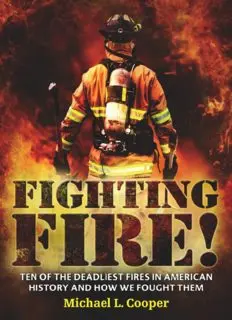
Fighting Fire!. Ten of the Deadliest Fires in American History and How We Fought Them PDF
Preview Fighting Fire!. Ten of the Deadliest Fires in American History and How We Fought Them
The author and publisher have provided this e-book to you for your personal use only. You may not make this e-book publicly available in any way. Copyright infringement is against the law. If you believe the copy of this e-book you are reading infringes on the author’s copyright, please notify the publisher at: us.macmillanusa.com/piracy. To my New York friends Russell and Jim who have always been so supportive CONTENTS Title Page Copyright Notice Dedication Introduction 1 COLONIAL AMERICA’S BIGGEST FIRE BOSTON, 1760 2 A TERRIBLE TORRENT OF FIRE NEW YORK, 1835 3 AMERICA’S MOST FAMOUS FIRE CHICAGO, 1871 4 NEW CENTURY, OLD PROBLEM BALTIMORE, 1904 5 FIRE ON THE WATER NEW YORK, 1904 6 AMERICA’S LAST GREAT URBAN FIRE SAN FRANCISCO, 1906 7 DEADLY WORKPLACE FIRE NEW YORK, 1911 8 NIGHTCLUB TRAGEDY BOSTON, 1942 9 9/11: FIRE IN THE SKY NEW YORK, 2001 10 WILDFIRE SAN DIEGO COUNTY, 2007 Fire Engines in American History Fire Museums to Visit Recommended Reading Websites to Visit Source Notes Glossary Bibliography Index Copyright INTRODUCTION A “dreadful city of fire” is how one visitor described colonial Boston. That’s because fires frequently destroyed large sections of the city. But it wasn’t a problem only in Boston or in the colonial era. Major fires regularly leveled cities up until the early twentieth century. Several of these fires shaped history. King George’s indifference to the suffering of Boston’s citizens after the big fire of 1760, some historians believe, added to the tensions that sparked the American Revolution. New York City’s Great Fire of 1835 prompted the building of the Croton Aqueduct, one of the nineteenth century’s grandest engineering feats. And the Great Chicago Fire of 1871 cleared the way for a new style of architecture that reshaped skylines around the world—the skyscraper. Many smaller American fires were no less significant in terms of developing firefighting and fire-safety techniques. In the early twentieth century, a fire aboard the General Slocum, a popular excursion boat in New York City, killed 1,021 people. A few months later in the same city, the Triangle Shirtwaist Company fire killed 146 young garment workers. Big or small, each fire resulted in innovations as well as stronger laws and regulations. Science and technology improved fire protection, fire detection, and firefighting. Despite these advances, fire is still a major threat. According to the National Fire Protection Association, U.S. fire departments responded to nearly 1.3 million fires in 2010. That’s one every 24 seconds. Those fires caused $11.6 billion in damage and killed 3,125 people, not including firefighters. Even with today’s technology, tragedies still occur. In late June 2013, a wildfire in central Arizona trapped and killed an elite group of 19 firefighters. Two months later, the Rim Fire, one of California’s biggest wildfires, burned more than 370 square miles of land, including a large portion of Yosemite National Park. It took some 1,500 firefighters about five weeks to fully contain the blaze. The following chapters show the destructive nature of fire through ten of the deadliest fires in American history. The challenges of firefighting have changed as our country has grown and modernized, but over the centuries these major fires have taught us valuable lessons that help prevent fires and save lives.
